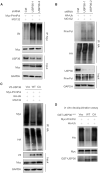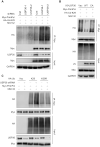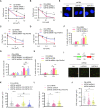The deubiquitinase USP36 Regulates DNA replication stress and confers therapeutic resistance through PrimPol stabilization
- PMID: 33237263
- PMCID: PMC7736794
- DOI: 10.1093/nar/gkaa1090
The deubiquitinase USP36 Regulates DNA replication stress and confers therapeutic resistance through PrimPol stabilization
Abstract
PrimPol has been recently identified as a DNA damage tolerant polymerase that plays an important role in replication stress response. However, the regulatory mechanisms of PrimPol are not well defined. In this study, we identify that the deubiquitinase USP36 interferes with degradation of PrimPol to regulate the replication stress response. Mechanistically, USP36 is deubiquitinated following DNA replication stress, which in turn facilitates its upregulation and interaction with PrimPol. USP36 deubiquitinates K29-linked polyubiquitination of PrimPol and increases its protein stability. Depletion of USP36 results in replication stress-related defects and elevates cell sensitivity to DNA-damage agents, such as cisplatin and olaparib. Moreover, USP36 expression positively correlates with the level of PrimPol protein and poor prognosis in patient samples. These findings indicate that the regulation of PrimPol K29-linked ubiquitination by USP36 plays a critical role in DNA replication stress and chemotherapy response.
© The Author(s) 2020. Published by Oxford University Press on behalf of Nucleic Acids Research.
Figures








Similar articles
-
PrimPol is required for the maintenance of efficient nuclear and mitochondrial DNA replication in human cells.Nucleic Acids Res. 2019 May 7;47(8):4026-4038. doi: 10.1093/nar/gkz056. Nucleic Acids Res. 2019. PMID: 30715459 Free PMC article.
-
PRIMPOL ready, set, reprime!Crit Rev Biochem Mol Biol. 2021 Feb;56(1):17-30. doi: 10.1080/10409238.2020.1841089. Epub 2020 Nov 12. Crit Rev Biochem Mol Biol. 2021. PMID: 33179522 Free PMC article. Review.
-
PRIMPOL competes with RAD51 to resolve G-quadruplex-induced replication stress via its interaction with RPA.Acta Biochim Biophys Sin (Shanghai). 2022 Nov 25;55(3):498-507. doi: 10.3724/abbs.2022165. Acta Biochim Biophys Sin (Shanghai). 2022. PMID: 36647718 Free PMC article.
-
Mitochondrial DNA replication: a PrimPol perspective.Biochem Soc Trans. 2017 Apr 15;45(2):513-529. doi: 10.1042/BST20160162. Biochem Soc Trans. 2017. PMID: 28408491 Free PMC article. Review.
-
Human CST complex restricts excessive PrimPol repriming upon UV induced replication stress by suppressing p21.Nucleic Acids Res. 2024 Apr 24;52(7):3778-3793. doi: 10.1093/nar/gkae078. Nucleic Acids Res. 2024. PMID: 38348929 Free PMC article.
Cited by
-
Identification of ubiquitinated substrate proteins and their gene expression patterns in lung adenocarcinoma.Ann Transl Med. 2021 Nov;9(22):1692. doi: 10.21037/atm-21-5645. Ann Transl Med. 2021. PMID: 34988201 Free PMC article.
-
An ATR-PrimPol pathway confers tolerance to oncogenic KRAS-induced and heterochromatin-associated replication stress.Nat Commun. 2023 Aug 17;14(1):4991. doi: 10.1038/s41467-023-40578-2. Nat Commun. 2023. PMID: 37591859 Free PMC article.
-
Suppression of ITPKB degradation by Trim25 confers TMZ resistance in glioblastoma through ROS homeostasis.Signal Transduct Target Ther. 2024 Mar 4;9(1):58. doi: 10.1038/s41392-024-01763-x. Signal Transduct Target Ther. 2024. PMID: 38438346 Free PMC article.
-
USP36 facilitates esophageal squamous carcinoma progression via stabilizing YAP.Cell Death Dis. 2022 Dec 5;13(12):1021. doi: 10.1038/s41419-022-05474-5. Cell Death Dis. 2022. PMID: 36470870 Free PMC article.
-
PrimPol: A Breakthrough among DNA Replication Enzymes and a Potential New Target for Cancer Therapy.Biomolecules. 2022 Feb 3;12(2):248. doi: 10.3390/biom12020248. Biomolecules. 2022. PMID: 35204749 Free PMC article. Review.
References
-
- Jain R., Aggarwal A.K., Rechkoblit O.. Eukaryotic DNA polymerases. Curr. Opin. Struct. Biol. 2018; 53:77–87. - PubMed
-
- Mouron S., Rodriguez-Acebes S., Martinez-Jimenez M.I., Garcia-Gomez S., Chocron S., Blanco L., Mendez J.. Repriming of DNA synthesis at stalled replication forks by human PrimPol. Nat. Struct. Mol. Biol. 2013; 20:1383–1389. - PubMed
Publication types
MeSH terms
Substances
LinkOut - more resources
Full Text Sources
Other Literature Sources
Medical
Research Materials

